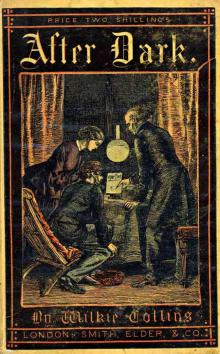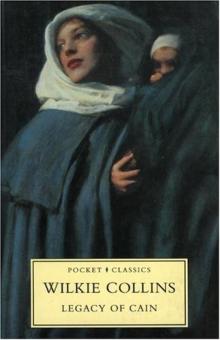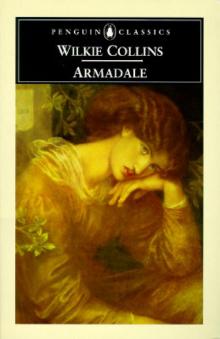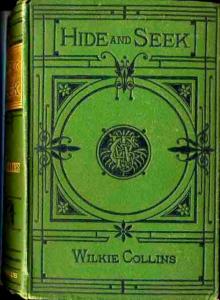- Home
- Wilkie Collins
Woman in White (Barnes & Noble Classics Series)
Woman in White (Barnes & Noble Classics Series) Read online
Table of Contents
FROM THE PAGES OF THE WOMAN IN WHITE
Title Page
Copyright Page
WILKIE COLLINS
THE WORLD OF WILKIE COLLINS AND THE WOMAN IN WHITE
Introduction
Dedication
Preface [1860]
Preface to the Present Edition [1861 ]
THE FIRST EPOCH
The Story begun by Walter Hartright, of Clement’s Inn, Teacher of Drawing.
I
II
III
IV
V
VI
VII
VIII
IX
X
XI
XII
XIII
XIV
XV
The Story continued by Vincent Gilmore, of Chancery Lane, Solicitor.
I
II
III
IV
The Story continued by Marian Halcombe, in Extracts from her Diary.
I
II
THE SECOND EPOCH
The Story continued by Marian Halcombe.
I
II
III
IV
V
VI
VII
VIII
IX
X
The Story continued by Frederick Fairlie, Esq., of Limmeridge House.
The Story continued by Eliza Michelson, Housekeeper at Blackwater Park.
I
II
The Story Continued in Several Narratives.
I. The Narrative of Hester Pinhorn, Cook in the Service of Count Fosco.
2. The Narrative of the Doctor.
3. The Narrative of Jane Gould.
4. The Narrative of the Tombstone.
5. The Narrative of Walter Hartright.
THE THIRD EPOCH
The Story continued by Walter Hartright.
I
II
III
IV
V
VI
VII
VIII
IX
X
XI
I
II
III
IV
V
VI
VII
I
II
III
ENDNOTES
INSPIRED BY THE WOMAN IN WHITE
COMMENTS & QUESTIONS
FOR FURTHER READING
FROM THE PAGES OF THE WOMAN IN WHITE
This is the story of what a Woman’s patience can endure, and what a Man’s resolution can achieve. (page 9)
There, as if it had that moment sprung out of the earth or dropped from the heaven—stood the figure of a solitary Woman, dressed from head to foot in white garments. (page 24)
For aught I knew to the contrary, the whole future of Laura Fairlie’s life might be determined, for good or for evil, by my winning or losing the confidence of the forlorn creature who stood trembling by her mother’s grave. (page 95)
‘In the mean time, let me thoroughly understand the object to be gained by my interview with Anne Catherick. Is there no doubt in your mind that the person who confined her in the Asylum was Sir Percival Glyde?’ (page 107)
Her looks and tones, when she spoke, were of a kind to make me more than serious—they distressed me. Her words, few as they were, betrayed a desperate clinging to the past which boded ill for the future. (page 141)
Who else is left you? No father, no brother—no living creature but the helpless, useless woman who writes these sad lines. (page 191)
His white mice live in a little pagoda of gaily-painted wirework, designed and made by himself. They are almost as tame as the canaries, and they are perpetually let out, like the canaries. They crawl all over him, popping in and out of his waistcoat, and sitting in couples, white as snow, on his capacious shoulders. He seems to be even fonder of his mice than of his other pets, smiles at them, and kisses them. (page 216)
‘Tell him, next, that crimes cause their own detection. There’s another bit of copy-book morality for you, Fosco. Crimes cause their own detection. What infernal humbug!’ (page 228)
‘Human ingenuity, my friend, has hitherto only discovered two ways in which a man can manage a woman. One way is to knock her down—a method largely adopted by the brutal lower orders of the people, but utterly abhorrent to the refined and educated classes above them. The other way (much longer, much more difficult, but, in the end, not less certain) is never to accept a provocation at a woman’s hands. It holds with animals, it holds with children, and it holds with women, who are nothing but children grown up.’ (page 317)
The nurse, on the first night in the Asylum, had shown her the marks on each article of her underclothing as it was taken off, and had said, not at all irritably or unkindly, ‘Look at your own name on your own clothes, and don’t worry us all any more about being Lady Glyde. She’s dead and buried; and you’re alive and hearty.’ (page 420)
All remembrance of the heartless injury the man’s crimes had inflicted; of the love, the innocence, the happiness he had pitilessly laid waste; of the oath I had sworn in my own heart to summon him to the terrible reckoning that he deserved—passed from my memory like a dream. I remembered nothing but the horror of his situation. I felt nothing but the natural human impulse to save him from a frightful death. (page 505)
My life hung by a thread—and I knew it. At that final moment, I thought with his mind; I felt with his fingers—I was as certain, as if I had seen it, of what he kept hidden from me in the drawer. (page 577)
A great crowd clamoured and heaved round the door. There was evidently something inside which excited the popular curiosity, and fed the popular appetite for horror. (page 612)
Published by Barnes & Noble Books
122 Fifth Avenue
New York, NY 10011
www.barnesandnoble.com/classics
The Woman in White was originally serialized in Charles Dickens’s periodical All the Year
Round from November 1859 to August 1860, and published in three volumes in
1860. The present text is that of the corrected “New Edition” of 1861.
Published in 2005 by Barnes & Noble Classics with new Introduction,
Notes, Biography, Chronology, Inspired By, Comments & Questions,
and For Further Reading.
Introduction, Notes, and For Further Reading
Copyright © 2005 by Camille Cauti.
Note on Wilkie Collins, The World of Wilkie Collins and
The Woman in White, Inspired by The Woman in White, and Comments & Questions
Copyright © 2005 by Barnes & Noble, Inc.
All rights reserved. No part of this publication may be reproduced or
transmitted in any form or by any means, electronic or mechanical,
including photocopy, recording, or any information storage and
retrieval system, without the prior written permission of the publisher.
Barnes & Noble Classics and the Barnes & Noble Classics colophon are
trademarks of Barnes & Noble, Inc.
The Woman in White
ISBN-13: 978-1-59308-280-2
eISBN : 978-1-411-43353-3
ISBN-10: 1-59308-280-0
LC Control Number 2004112708
Produced and published in conjunction with:
Fine Creative Media, Inc.
322 Eighth Avenue
New York, NY 10001
Michael J. Fine, President & Publisher
Printed in the United States of America
QM<
br />
5 7 9 10 8 6 4
WILKIE COLLINS
William Wilkie Collins was born in London on January 8, 1824, to William and Harriet Collins. William Collins was a landscape painter who gained financial security by courting aristocratic patronage; his strict Tory (conservative) political views would later contrast with the bohemianism and political progressiveness of his son. Young Wilkie found more in common with his free-spirited mother, whose family included several successful artists. Before her marriage, Harriet also painted and supported herself by teaching and working as a governess; she exhibited an independence of character that would inspire a number of Wilkie’s fictional heroines.
William was determined to provide his two sons every social opportunity: He sent them to private schools, and Wilkie’s childhood included extended travels in Europe and training in painting. After exhibiting landscape paintings at the Royal Academy and serving an apprenticeship at a tea-importing firm, Collins began writing; he published his first story, “The Last Stage Coachman,” in 1843. In response to increasing pressure from his ailing father to abandon writing, Collins studied law at Lincoln’s Inn. After his father died in 1847, Collins began to pursue writing as a career and never practiced law; however, his legal training served him well when he wrote the first English-language detective stories.
Collins met Charles Dickens in 1851, and their ensuing friendship proved personally and professionally fortuitous. Over the next decade, with Dickens as an active mentor and publisher of his work,. Collins wrote prolifically. In 1859 he met Caroline Graves, a widow, who remained, with some interruptions, his companion until his death. A simultaneous long-term affair with Martha Rudd earned him a scandalous reputation, even among open-minded literati. Collins’s unorthodox personal life did little to harm his literary success. Over the course of his career, he published more than twenty-six novels, including The Woman in White (1860), which made him one of Britain’s most popular writers; the other novels Basil (1852), No Name (1862), and The Moonstone (1868); and countless stories, articles, plays, and essays.
Productive until his final years, Wilkie Collins suffered from increasing ill health and laudanum addiction until his death on September 23, 1889. Although some of his work is perhaps overtly didactic in dealing with difficult social issues, Collins’s writings are extremely varied and provide remarkable prototypes for the femme fatale and the modern detective novel.
THE WORLD OF WILKIE COLLINS AND THE WOMAN IN WHITE
1824 William Wilkie Collins is born in London on January 8 to William and Harriet Collins. His father is a Royal Academy landscape artist with Tory (conservative) political leanings.
1828 Wilkie’s brother, Charles Allston Collins, is born.
1832 Britain’s first Reform Bill almost doubles the number of voters, mostly members of the middle class.
1833 The British Factory Act is passed, prohibiting the employment of children under age nine and introducing factory inspections. Slavery is outlawed in the British Empire.
1835 Wilkie and his brother attend the Maida Hill Academy.
1836- 1838 The Collins family lives in France, Germany, and Italy. Wilkie refines his painting skills by studying the work of the old masters in Rome.
1837 The People’s Charter, a British working-class movement, is founded; the struggle for universal suffrage begins. Victoria becomes queen.
1838 Wilkie attends Reverend Henry Cole’s school. Charles Dickens’s Oliver Twist is published. The National Gallery opens in London.
1839 The Opium War breaks out between Britain and China.
1841 Collins becomes an apprentice at the tea-importing firm of Antrobus and Company.
1842 Collins begins writing. He travels to Scotland with his father. Factory workers strike in Manchester and other British industrial cities.
1843 Wordsworth becomes poet laureate. Collins’s first story, “The Last Stage Coachman,” appears in the Illuminated Magazine.
1844 Collins and his friend Charles Ward travel to Paris. John Stuart Mill’s Essays on Some Unsettled Questions of Political Economy is published. J. M. W Turner paints Rain, Steam, and Speed—The Great Western Railway, in a style that is a distinct contrast to William Collins’s landscapes.
1845 Iólani; or Tahiti as It Was, a Romance, Collins’s first attempt at a novel, is rejected by publishers Chapman and Hall. Frederick Engels’s The Condition of the Working Class in England is published.
1846 Collins studies law at Lincoln’s Inn. The failure of the potato crop in Ireland leads to widespread famine.
1847 Wilkie’s father, William Collins, dies, and Wilkie begins work on his biography. Charlotte Bronte’s Jane Eyre is published. Emily Brontë’s Wuthering Heights appears.
1848 Memoirs of the Life of William Collins, Esq., R.A. is published. Elizabeth Gaskell’s novel Mary Barton: A Tale of a Manchester Life appears. Karl Marx’s Communist Manifesto is published. Revolutions break out all over the Continent.
1849 Collins’s painting The Smuggler’s Retreat is exhibited at the Royal Academy. He and Charles Ward again visit France.
1850 A Court Duel, Collins’s first play (an adaptation of J. P. Simon and Edmond Badon’s Monsieur Lockray), is performed in London. His first novel, Antonina; or, the Fall of Rome, is published.
1851 A travel book, Rambles Beyond Railways, is published. Collins meets Charles Dickens when the two play roles in a London theatrical production. The Great Exhibition of new technology is held at the Crystal Palace in London. Mr. Wray’s Cash-Box is published.
1852 Collins’s “A Terribly Strange Bed” appears, his first story to be published in Dickens’s magazine Household Words. Basil: A Story of Modern Life is published by Bentley Press. Dickens’s Bleak House is published.
1853 Collins suffers an attack of the rheumatism that will plague him in later years. He recovers and tours Switzerland and Italy with Dickens and Augustus Egg.
1854 Hide and Seek is published.
1855 Dickens’s Tavistock House theater produces Collins’s first play, The Lighthouse.
1856 After Dark, Collins’s first book of short stories, is published. A Rogue’s Life is serialized in Household Words. At Dickens’s invitation, Collins joins the staff of the magazine. Collins continues to experience bouts of illness.
1857 Household Words begins serialization of The Dead Secret; it is published
in book form later in the year. The Divorce and Matrimonial Causes Act is passed.
1858 Collins’s play The Red Vial opens at the Olympic Theatre but is not successful.
1859 Collins meets and moves in with Caroline Graves, a widow. In November, Dickens’s new magazine All the Year Round begins to publish installments of The Woman in White, which gains widespread popularity. Charles Darwin’s On the Origin of Species and Dickens’s A Tale of Two Cities are published.
1860 Collins’s brother marries Kate, Charles Dickens’s daughter. In August, The Woman in White is published in book form by Sampson Low. The best-selling novel makes Collins one of Britain’s most popular writers.
1861 Collins is elected to the Athenaeum, a club that includes such illustrious members as Charles Darwin and Robert Browning.
1862 No Name is serialized and published in book form. In response to increasingly ill health, Collins begins taking the pain killer laudanum.
1863 Collins travels to Italy, France, and the Isle of Man with Caroline. My Miscellanies, an anthology of journalism, appears. John Stuart Mill’s Utilitarianism is published.
1864 On a summer trip to Yarmouth, Collins meets Martha Rudd, who will become another longtime lover. Armadale is serialized in the Cornhill Magazine. The Contagious Diseases Act, which allows police to perform arbitrary strip-searches of prostitutes, is passed.
1866 Collins’s play The Frozen Deep is performed at the Olympic Theatre. Armadale is published in book form.
1867 Dickens and Collins collaborate on the play No Thoroughfare. Matthew Arnold’s poem “Dover Beach” is published. Th
e British Parliament passes the Second Reform Bill, doubling the number of eligible voters by reducing the property qualification.
1868 The Moonstone, the first detective story in English, is serialized in All the Year Round and then published in book form by William Tinsley. Dickens grows increasingly intolerant of Collins’s unconventional romantic life. Perhaps out of jealously over his
relationship with Martha Rudd, Caroline marries another man.
1869 Black and White opens at the Adelphi Theatre. Marian, Collins’s daughter with Martha Rudd, is born. Martha Rudd uses the name “Dawson,” and all of her and Collins’s children are surnamed Dawson. Man and Wife is serialized in Cassell’s Magazine.
1870 Charles Dickens dies. Man and Wife is published in book form.
1871 Caroline Graves returns to live with Collins. He keeps a separate establishment for Martha Rudd. Another daughter, Harriet, is born to Collins and Martha. The Woman in White appears at the Olympic Theatre. Labor Unions are legalized in Britain. George Eliot’s Middlemarch is published.
1872 The New Magdalen is serialized in Temple Bar magazine.
1873 Collins embarks on a reading tour of the United States; he meets Mark Twain and Henry Wadsworth Longfellow. The New Magdalen is published in book form.
1874 Collins’s son with Rudd, William Charles Collins Dawson, is born. The Law and the Lady is serialized in The Graphic.
1875 The Public Health Act is passed in Britain. The Law and the Lady is published in book form.

 The Woman in White
The Woman in White The Queen of Hearts
The Queen of Hearts Miss Jeromette and the Clergyman
Miss Jeromette and the Clergyman Man and Wife
Man and Wife The Legacy of Cain
The Legacy of Cain Armadale
Armadale The Frozen Deep
The Frozen Deep John Jago's Ghost or the Dead Alive
John Jago's Ghost or the Dead Alive Poor Miss Finch
Poor Miss Finch The Cauldron of Oil: A Case Worth Looking At
The Cauldron of Oil: A Case Worth Looking At The Poisoned Meal
The Poisoned Meal The Moonstone
The Moonstone My Lady's Money
My Lady's Money Classic Ghost Stories
Classic Ghost Stories Jezebel's Daughter
Jezebel's Daughter The Devil's Spectacles
The Devil's Spectacles I Say No
I Say No Miss or Mrs.?
Miss or Mrs.? Nine O'Clock
Nine O'Clock The Lawyer's Story of a Stolen Letter
The Lawyer's Story of a Stolen Letter The Two Destinies
The Two Destinies Mr. Percy and the Prophet
Mr. Percy and the Prophet The Law and the Lady
The Law and the Lady The Nun's Story of Gabriel's Marriage
The Nun's Story of Gabriel's Marriage After Dark
After Dark Mr. Captain and the Nymph
Mr. Captain and the Nymph No Name
No Name The Moonstone (Penguin Classics)
The Moonstone (Penguin Classics) Antonina
Antonina Woman in White (Barnes & Noble Classics Series)
Woman in White (Barnes & Noble Classics Series) Miss or Mrs
Miss or Mrs The Dead Alive
The Dead Alive Basil
Basil A Rogue's Life
A Rogue's Life The New Magdalen
The New Magdalen Blind Love
Blind Love Little Novels
Little Novels The Lazy Tour of Two Idle Apprentices
The Lazy Tour of Two Idle Apprentices The Haunted Hotel
The Haunted Hotel Hide and Seek
Hide and Seek